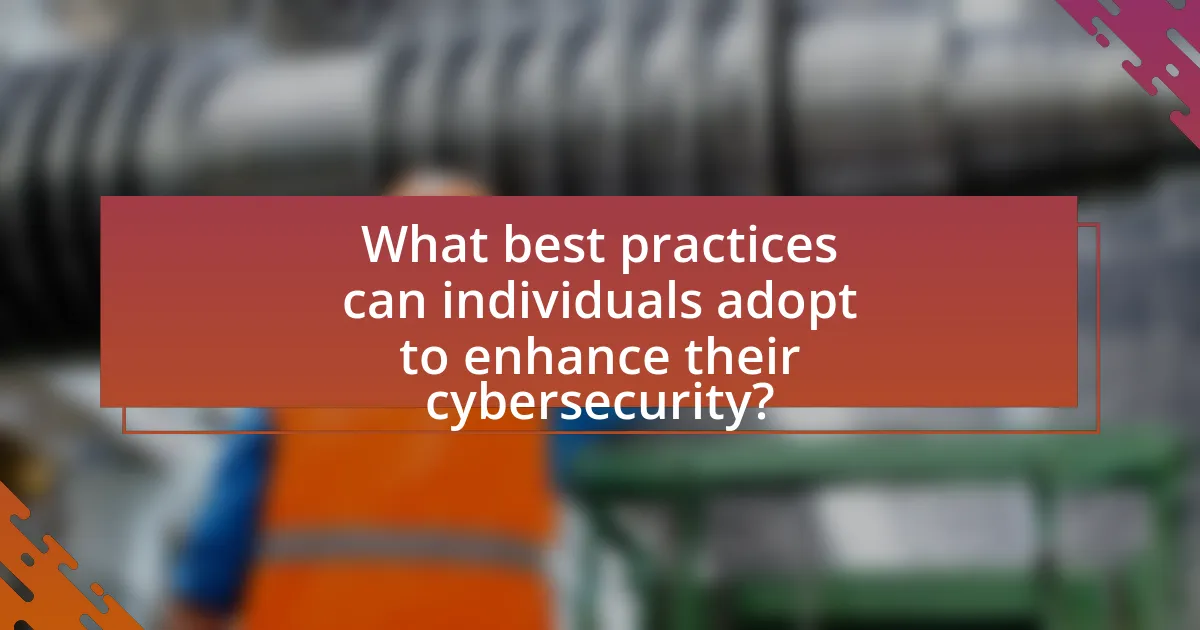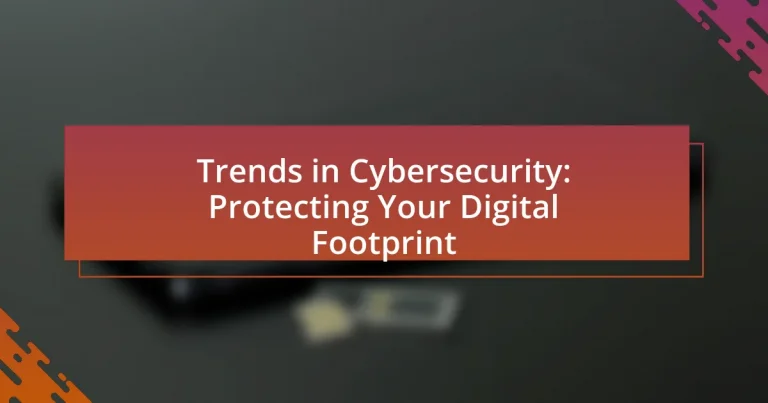The article focuses on current trends in cybersecurity aimed at protecting digital footprints, highlighting the use of artificial intelligence (AI) for threat detection, the implementation of zero-trust security models, and the adoption of privacy-enhancing technologies. It discusses how emerging technologies, particularly AI and machine learning, are reshaping cybersecurity practices by improving threat prediction and response. The article also outlines common threats to digital footprints, such as data breaches and phishing attacks, and emphasizes the importance of safeguarding personal information through best practices like strong passwords and two-factor authentication. Additionally, it addresses the long-term consequences of compromised digital footprints and provides practical steps individuals can take to enhance their cybersecurity posture.

What are the current trends in cybersecurity for protecting your digital footprint?
Current trends in cybersecurity for protecting your digital footprint include the increased use of artificial intelligence (AI) for threat detection, the implementation of zero-trust security models, and the adoption of privacy-enhancing technologies. AI enhances threat detection by analyzing vast amounts of data to identify anomalies and potential breaches in real-time, significantly reducing response times. Zero-trust security models operate on the principle of “never trust, always verify,” ensuring that every access request is authenticated and authorized, thereby minimizing the risk of unauthorized access. Privacy-enhancing technologies, such as data anonymization and encryption, are increasingly utilized to safeguard personal information from unauthorized access and data breaches. These trends reflect a proactive approach to cybersecurity, addressing the growing complexity of digital threats and the need for robust protection of personal data.
How are emerging technologies shaping cybersecurity practices?
Emerging technologies are significantly shaping cybersecurity practices by introducing advanced tools and methodologies that enhance threat detection and response. For instance, artificial intelligence (AI) and machine learning (ML) are being utilized to analyze vast amounts of data in real-time, enabling organizations to identify anomalies and potential threats more efficiently. According to a report by Gartner, AI-driven cybersecurity solutions are expected to reduce security incidents by up to 30% by 2025, demonstrating their effectiveness in proactive threat management. Additionally, the adoption of blockchain technology is enhancing data integrity and security through decentralized verification processes, making it harder for cybercriminals to manipulate data. These advancements illustrate how emerging technologies are not only transforming cybersecurity practices but also improving overall digital resilience.
What role does artificial intelligence play in enhancing cybersecurity?
Artificial intelligence significantly enhances cybersecurity by automating threat detection and response. AI algorithms analyze vast amounts of data to identify patterns indicative of cyber threats, enabling quicker identification of anomalies that may signify breaches. For instance, according to a report by McKinsey, organizations using AI for cybersecurity can reduce incident response times by up to 90%. Additionally, AI-driven systems can adapt and learn from new threats, improving their effectiveness over time. This capability is crucial as cyber threats evolve rapidly, making traditional security measures less effective.
How is machine learning being utilized to predict cyber threats?
Machine learning is utilized to predict cyber threats by analyzing vast amounts of data to identify patterns and anomalies indicative of potential attacks. This technology employs algorithms that learn from historical data, enabling systems to recognize unusual behavior that may signify a cyber threat, such as phishing attempts or malware infections. For instance, a study by IBM found that organizations using machine learning for threat detection can reduce the time to identify and contain breaches by up to 27%. Additionally, machine learning models can continuously improve their accuracy by adapting to new data, making them increasingly effective in predicting and mitigating cyber threats over time.
What are the most common threats to digital footprints today?
The most common threats to digital footprints today include data breaches, phishing attacks, and identity theft. Data breaches occur when unauthorized individuals gain access to sensitive information, often resulting in the exposure of personal data. For instance, the 2020 Facebook data breach compromised the personal information of over 500 million users, highlighting the vulnerability of digital footprints. Phishing attacks involve deceptive communications that trick individuals into revealing personal information, with a reported increase of 600% in such attacks during the COVID-19 pandemic. Identity theft, where personal information is used fraudulently, affects millions annually, with the Federal Trade Commission reporting over 1.4 million identity theft cases in 2020 alone. These threats underscore the importance of vigilance in protecting digital footprints.
How do phishing attacks compromise personal information?
Phishing attacks compromise personal information by deceiving individuals into providing sensitive data through fraudulent communications, often appearing to be from legitimate sources. These attacks typically involve emails or messages that contain links to fake websites designed to mimic trusted entities, such as banks or social media platforms. According to the Anti-Phishing Working Group, in 2021, there were over 200,000 reported phishing attacks, highlighting the prevalence of this threat. When users enter their personal information, such as passwords or credit card numbers, on these counterfeit sites, attackers capture this data for malicious purposes, leading to identity theft and financial loss.
What impact do ransomware attacks have on individuals and organizations?
Ransomware attacks significantly disrupt both individuals and organizations by encrypting data and demanding payment for its release. For individuals, this can lead to loss of personal files, financial strain from ransom payments, and emotional distress. For organizations, the impact includes operational downtime, loss of sensitive data, financial losses estimated at billions annually, and damage to reputation. According to a report by Cybersecurity Ventures, global ransomware damages are projected to reach $265 billion by 2031, highlighting the severe financial implications for both sectors.
Why is protecting your digital footprint essential in today’s digital landscape?
Protecting your digital footprint is essential in today’s digital landscape because it safeguards personal information from unauthorized access and misuse. With over 4.9 billion internet users globally, the risk of identity theft, cyberbullying, and data breaches has significantly increased. According to the Identity Theft Resource Center, there were over 1,100 data breaches reported in 2020 alone, exposing millions of records. By managing and minimizing one’s digital footprint, individuals can reduce their vulnerability to these threats and maintain greater control over their personal data.
What are the potential consequences of a compromised digital footprint?
A compromised digital footprint can lead to identity theft, financial loss, and reputational damage. When personal information is exposed, cybercriminals can impersonate individuals to access bank accounts or make unauthorized purchases, resulting in significant financial repercussions. According to the Identity Theft Resource Center, in 2020, there were over 1,100 reported data breaches, affecting millions of individuals and leading to an increase in identity theft cases. Additionally, a compromised digital presence can harm an individual’s reputation, as sensitive information may be misused or publicly shared, impacting personal and professional relationships.
How can identity theft affect your financial and personal life?
Identity theft can severely impact both financial and personal life by leading to significant monetary losses and emotional distress. Victims often face unauthorized transactions, which can result in drained bank accounts and damaged credit scores; according to the Federal Trade Commission, identity theft resulted in over $3.3 billion in reported losses in 2020 alone. Additionally, individuals may experience long-term repercussions, such as difficulty obtaining loans or housing due to tarnished credit histories. The emotional toll includes stress, anxiety, and a sense of violation, as victims must navigate the complex process of reclaiming their identity and finances.
What long-term effects can data breaches have on individuals?
Data breaches can have significant long-term effects on individuals, including identity theft, financial loss, and emotional distress. Identity theft can lead to unauthorized transactions and damage to credit scores, as evidenced by a 2020 report from the Identity Theft Resource Center, which found that 1 in 15 Americans were victims of identity theft. Financial loss can result from fraudulent activities, with the Federal Trade Commission reporting that victims of identity theft lost an average of $1,000. Additionally, emotional distress, such as anxiety and loss of trust in digital systems, can persist long after the breach, impacting individuals’ mental health and willingness to engage online.
How can individuals assess their current cybersecurity posture?
Individuals can assess their current cybersecurity posture by conducting a comprehensive security audit that evaluates their devices, networks, and online behaviors. This audit should include reviewing software and hardware for vulnerabilities, ensuring that all systems are updated with the latest security patches, and using tools like vulnerability scanners to identify weaknesses. According to a 2021 report by Cybersecurity & Infrastructure Security Agency (CISA), organizations that regularly assess their cybersecurity posture are 50% less likely to experience a significant breach. Additionally, individuals should implement multi-factor authentication and regularly change passwords to enhance security, as these practices significantly reduce the risk of unauthorized access.
What tools are available for evaluating personal cybersecurity risks?
Tools available for evaluating personal cybersecurity risks include security assessment software, vulnerability scanners, and risk assessment frameworks. Security assessment software, such as Norton Security and McAfee Total Protection, provides comprehensive evaluations of personal devices for malware and security vulnerabilities. Vulnerability scanners like Nessus and OpenVAS identify weaknesses in systems and networks, allowing users to address potential threats. Additionally, risk assessment frameworks such as the NIST Cybersecurity Framework offer structured approaches for individuals to assess their cybersecurity posture, including identifying risks and implementing mitigation strategies. These tools are essential for understanding and managing personal cybersecurity risks effectively.
How can one identify vulnerabilities in their online presence?
One can identify vulnerabilities in their online presence by conducting a comprehensive security assessment that includes analyzing personal data exposure, reviewing account security settings, and utilizing vulnerability scanning tools. Personal data exposure can be assessed by searching for information about oneself on data broker sites and social media platforms, which often reveal sensitive information. Reviewing account security settings involves checking for weak passwords, enabling two-factor authentication, and ensuring privacy settings are appropriately configured. Vulnerability scanning tools, such as Qualys or Nessus, can identify security weaknesses in websites and online accounts. According to a 2021 report by Cybersecurity Ventures, 60% of small businesses experienced a cyberattack, highlighting the importance of proactive vulnerability identification to mitigate risks.

What best practices can individuals adopt to enhance their cybersecurity?
Individuals can enhance their cybersecurity by adopting strong password practices, enabling two-factor authentication, and regularly updating software. Strong passwords should be complex, combining letters, numbers, and symbols, and should not be reused across different accounts. According to a 2021 study by the Cybersecurity & Infrastructure Security Agency, 81% of data breaches are linked to weak or stolen passwords. Enabling two-factor authentication adds an extra layer of security, making it significantly harder for unauthorized users to gain access. Regularly updating software ensures that individuals benefit from the latest security patches, as outdated software is a common target for cyberattacks. The National Cyber Security Centre emphasizes that timely updates can mitigate vulnerabilities that hackers exploit.
How can strong passwords protect your digital footprint?
Strong passwords protect your digital footprint by significantly reducing the risk of unauthorized access to your online accounts. When passwords are complex, incorporating a mix of letters, numbers, and symbols, they become more resistant to brute-force attacks, where hackers systematically try combinations to gain entry. According to a study by the National Institute of Standards and Technology (NIST), using passwords that are at least 12 characters long can enhance security by making it exponentially harder for attackers to crack them. Additionally, strong passwords help safeguard personal information, financial data, and sensitive communications, thereby maintaining the integrity of one’s digital identity and minimizing the potential for identity theft or data breaches.
What are the characteristics of a strong password?
A strong password is characterized by its length, complexity, and unpredictability. Specifically, it should be at least 12 to 16 characters long, incorporating a mix of uppercase letters, lowercase letters, numbers, and special symbols. This combination significantly increases the difficulty of password cracking attempts. Research indicates that passwords with these characteristics can take years or even centuries to crack using brute-force methods, as demonstrated by studies from cybersecurity experts like those at the National Institute of Standards and Technology (NIST). Additionally, a strong password should avoid common words, phrases, or easily guessable information such as birthdays or names, further enhancing its security.
How often should passwords be updated for optimal security?
Passwords should be updated every three to six months for optimal security. This recommendation is supported by cybersecurity experts who emphasize that regular updates reduce the risk of unauthorized access, especially in light of frequent data breaches. The National Institute of Standards and Technology (NIST) suggests that changing passwords periodically can help mitigate the impact of compromised credentials, reinforcing the importance of this practice in maintaining digital security.
What role does two-factor authentication play in cybersecurity?
Two-factor authentication (2FA) significantly enhances cybersecurity by adding an extra layer of security beyond just a password. This method requires users to provide two different forms of identification before accessing an account, typically something they know (a password) and something they have (a mobile device or security token). According to a report by Google, implementing 2FA can block up to 99.9% of automated attacks, demonstrating its effectiveness in preventing unauthorized access. By requiring multiple forms of verification, 2FA reduces the risk of account breaches, thereby protecting sensitive information and contributing to overall digital security.
How can enabling two-factor authentication reduce the risk of unauthorized access?
Enabling two-factor authentication (2FA) significantly reduces the risk of unauthorized access by requiring a second form of verification beyond just a password. This additional layer of security ensures that even if a password is compromised, an attacker would still need access to the second factor, which is typically a device or application that only the legitimate user possesses. According to a study by Google, implementing 2FA can block 100% of automated bots and 99% of bulk phishing attacks, demonstrating its effectiveness in safeguarding accounts against unauthorized access.
What are the different methods of two-factor authentication available?
The different methods of two-factor authentication (2FA) available include SMS-based verification, authenticator apps, hardware tokens, biometric verification, and email-based codes. SMS-based verification sends a one-time code to the user’s mobile device, while authenticator apps generate time-based codes that the user must enter. Hardware tokens are physical devices that produce a code, and biometric verification uses unique physical characteristics, such as fingerprints or facial recognition, to authenticate users. Email-based codes send a verification link or code to the user’s registered email address. These methods enhance security by requiring a second form of verification beyond just a password, significantly reducing the risk of unauthorized access.
What practical steps can individuals take to safeguard their online activities?
Individuals can safeguard their online activities by implementing strong, unique passwords for each account and enabling two-factor authentication (2FA) wherever possible. Strong passwords reduce the risk of unauthorized access, while 2FA adds an additional layer of security by requiring a second form of verification, such as a text message or authentication app. According to a study by Google, 2FA can block 100% of automated bots and 96% of phishing attacks, demonstrating its effectiveness in enhancing online security. Additionally, individuals should regularly update their software and devices to protect against vulnerabilities, as outdated systems are often targeted by cybercriminals.




